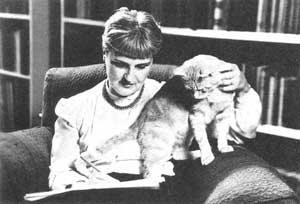https://www.youtube.com/watch?v=er8-Vq__cRE
In 2007 John Maloof bought a mysterious box of 30,000 negatives for $380, hoping to find some photos of Chicago for a history book he was writing. What he discovered he'd bought was the amazing work of an unknown photographer, who amassed her collection mainly while working as a nanny, from 1949 to 2009 when she died. So bowled over was he that he has since tracked down the other lots which he failed to buy at the auction, now owning 90 per cent of her work. The remaining lot had been bought by another collector, Jeff Goldstein, who also produced his own Vivian Maier archive, touring exhibition and a book called Vivian Maier: Out of the Shadows. All of this despite the MoMA showing no interest when Maloof aproached them for a professional opinion.
Maloof himself began by posting some of the pictures on his blog to garner opinions, and on Flickr discussions went viral. He turned detective, tracking down acquaintances, discovering she was born in the Bronx in 1926 to parents of French and Austro Hungarian extraction, documenting all of his findings, until he joined forces with the filmmaker Charlie Siskel, who comments 'It would be a great story even if the work was ok, but the fact that the work is so good is what gives it its staying power.' But also what seems to give it depth is the obsessiveness of Maloof's investigations framing the unorthodox and eccentric story of Vivian.
Nowadays her prints are available through the Howard Greenberg Gallery, New York, and profits have enabled Maloof to set up The Vivian Maier Scholarship to assist young photographers in need of financial support. Maloof insists 'We wanted to give back.' and 'I still do feel a responsibility to Vivian'
 http://vivianmaier.blogspot.co.uk/
http://vivianmaier.blogspot.co.uk/ Summer has kicked in with a vengeance, but I think my summer started
this year with 'Souvenir', the Voice Project's latest contribution to
the Norwich festival, using the grand scale grounds of Holkham Hall in
Norfolk. I always try to view/hear what Sian Croose has produced, and of
late she has gone from strength to strength by focusing on making the
most of both external and internal spaces, while breaking down the usual
limits and barriers of performers on stage, audience in the auditorium.
On this occasion I attended the middle performance, which I suspect was
the most beautiful, with the benefit of the golden hour creating
magical shadows, an atmosphere that seemed to conjure up a cross between
a Seurat and a Magritte painting. The last performance in the evening
probably gave a fair challenge with sunset, dusk and twilight to
challenge the warm glow of the afternoon, but I am still happy with my
choice. Although if it had been on again the following weekend, I would
have wanted to go again, so who knows which I would have chosen then....
Summer has kicked in with a vengeance, but I think my summer started
this year with 'Souvenir', the Voice Project's latest contribution to
the Norwich festival, using the grand scale grounds of Holkham Hall in
Norfolk. I always try to view/hear what Sian Croose has produced, and of
late she has gone from strength to strength by focusing on making the
most of both external and internal spaces, while breaking down the usual
limits and barriers of performers on stage, audience in the auditorium.
On this occasion I attended the middle performance, which I suspect was
the most beautiful, with the benefit of the golden hour creating
magical shadows, an atmosphere that seemed to conjure up a cross between
a Seurat and a Magritte painting. The last performance in the evening
probably gave a fair challenge with sunset, dusk and twilight to
challenge the warm glow of the afternoon, but I am still happy with my
choice. Although if it had been on again the following weekend, I would
have wanted to go again, so who knows which I would have chosen then....

 Going back to the 17th Century, Mary Beale was a portraitist heavily influenced by Peter Lily. She was born in Barrow, Suffolk; her self-portrait is included in the exhibition.
Going back to the 17th Century, Mary Beale was a portraitist heavily influenced by Peter Lily. She was born in Barrow, Suffolk; her self-portrait is included in the exhibition.